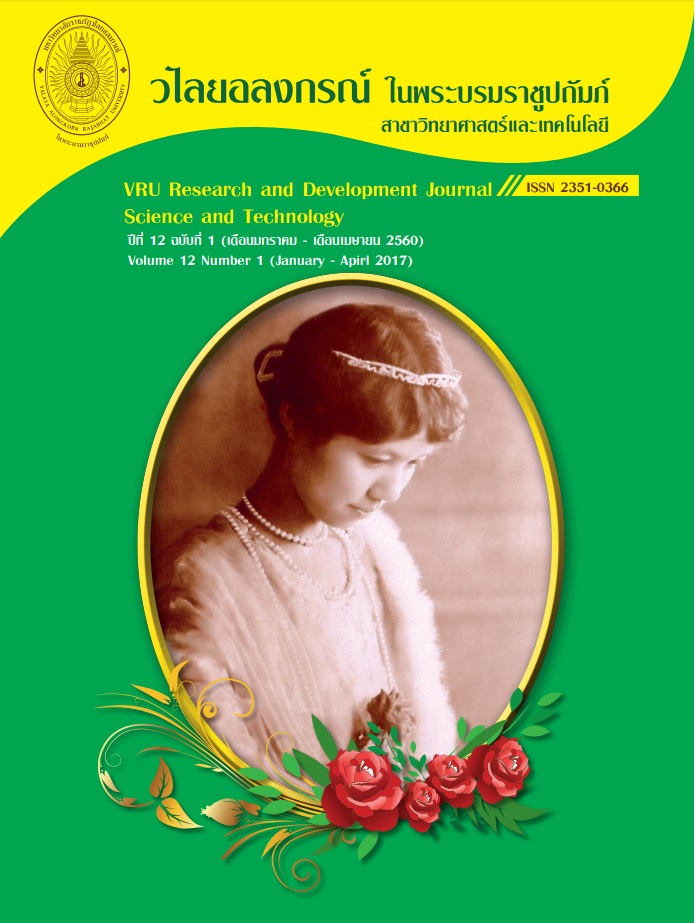การสังเคราะห์และคุณสมบัติของซีโอไลต์สี่เอสำหรับการดูดซับโลหะหนัก
Main Article Content
บทคัดย่อ
แร่หลักในดินขาวคือเกาลิไนต์ซึ่งมีสูตรทางเคมีเป็น Al2O3.2SiO2.2H2O และโครงสร้างประกอบด้วยซิลิกาเตตระฮีดรอลและอลูมินาออกตะฮีดรอลรวมกันเป็นรูปแบบชั้นหน่วยของดินขาว วัตถุประสงค์ของงานวิจัยนี้เพื่อสังเคราะห์ซีโอไลต์สี่เอจากดินขาวธรรมชาติในประเทศไทยด้วยกระบวนการเมตาเกาลินไนเซชันและซีโอไลต์เซชัน สารตัวอย่างที่ใช้คือดินขาวธรรมชาติจากจังหวัดระนอง ดินขาวแห้งประมาณ 600 กรัม ถูกคัลไซน์ที่อุณหภูมิ 400-700 องศาเซลเซียส เป็นเวลา 3 ชั่วโมง หลังจากนั้นนำ 500 กรัมของเมตาเกาลินไนต์มาทำการกวนด้วยสารละลายโซเดียมไฮดรอกไซน์ความเข้มข้น 0.5-3.5 โมลาร์ ที่อุณหภูมิ 70-90 องศาเซลเซียส วัตถุดิบและผลิตภัณฑ์ถูกตรวจสอบคุณสมบัติด้วยเทคนิคการเลี้ยวเบนของรังสีเอกซ์ (XRD) กล้องจุลทรรศน์อิเลคตรอนแบบส่องกราด (SEM) และเอกซ์เรย์ฟลูออเรสเซนต์ (XRF) ผลของการทดลองพบว่าดินขาวประกอบด้วยเกาลินไนต์เป็นองค์ประกอบหลัก ลักษณะผลึกของซีโอไลต์สี่เอที่สังเคราะห์ได้มีรูปทรงเป็นลูกบาศก์ขนาดประมาณ 2 ไมโครเมตร และองค์ประกอบของดินขาวประกอบด้วยซิลิกาและอะลูมินาเป็นองค์ประกอบหลัก การวิจัยนี้สรุปได้ว่าดินขาวระนองสามารถเตรียมเป็นซีโอไลต์สี่เอได้ โดยการกระตุ้นดินขาวด้วยสารละลายโซเดียมไฮดรอกไซด์ภายใต้สภาวะที่เหมาะสม ที่อุณหภูมิ 90 องศาเซลเซียส เป็นเวลา 3 ชั่วโมง และการตกผลึกที่อุณหภูมิ 600 องศาเซลเซียส เป็นเวลา 3 ชั่วโมง ร้อยละการดูดซับโลหะหนักตะกั่ว แคดเมียม และทองแดง คือ 97.01 96.95 และ 97.12 ตามลำดับ
The principal mineral in clay is kaolinite having a chemical formular Al2O3.2SiO2.2H2O and the structure consists of a single silica tetrahedral sheet and a single alumina octahedral sheet combined to form the clay unit layer. The purpose of this research was to synthesize zeolite-4A from the natural clay in Thailand via a metakaolinization and zeolitezation process. The sample used was natural clays from Ranong province. About 600 g of clay was calcined at 400-700 OC for 3 h. About 500 g of the metakaolinite was dissolved in 0.5-3.5 M NaOH followed by ageing at 70-90 OC. Both of the raw materials and the final product were characterized by X-ray Diffraction (XRD), Scanning Electron Microscope (SEM) and X-ray Fluorescence (XRF). The experimental results were showed that Ranong clay consisted of kaolinite. The zeolite-4A was cubical edge and the crystal size was estimated to be 2 μm; and clay consisted mainly of silica and alumina. It can be concluded that clay used as raw material in this experiment is the kaolinite that as the zeolite-4A which was prepared from clay by activation treatment using sodium hydroxide under the proper condition. The optimum parameters can be prepared zeolite-4A from clay by ageing at 90 OC for 3 h and crystallized at 600 OC for 3 h. For adsorption characteristic of synthesized zeolite-4A, adsorption percentage of lead cadmium and copper were 97.01 96.95 and 97.12 respectively.
Article Details
ลิขสิทธิ์บทความวิจัยที่ได้รับการตีพิมพ์เผยแพร่ในวารสารวิจัยและพัฒนา วไลยอลงกรณ์ ในพระบรมราชูปถัมภ์ ถือเป็นกรรมสิทธิ์ของสถาบันวิจัยและพัฒนา มหาวิทยาลัยราชภัฏวไลยอลงกรณ์ ในพระบรมราชูปถัมภ์ ห้ามนำข้อความทั้งหมดหรือบางส่วนไปพิมพ์ซ้ำ เว้นแต่จะได้รับอนุญาตจากมหาวิทยาลัยเป็นลายลักษณ์อักษร
ความรับผิดชอบ เนื้อหาต้นฉบับที่ปรากฏในวารสารวิจัยและพัฒนา วไลยอลงกรณ์ ในพระบรมราชูปถัมภ์ เป็นความรับผิดชอบของผู้นิพนธ์บทความหรือผู้เขียนเอง ทั้งนี้ไม่รวมความผิดพลาดอันเกิดจากเทคนิคการพิมพ์
References
D. Akolekar, A. Chaffee and R. F. Howe. (1997). The transformation of kaolin to low-silica X zeolite. Zeolites. 19, 359-365.
D. Georgiev, B. Bogdanov, K. Angelova, I. Markovska and Y. Hristov. (2009). Synthetic Zeolite – Structure, Clasification, Current Trends in Zeolite Synthesis Review. International Science conference 4th-5th June 2009, Stara Zagora, BULGARIA.
D. Novembre, B. Di Sabatino, D. Gimeno, M. Garcia and S. Martinez. (2004). Synthesis of Na-X zeolite from tripolaceous deposits (Crotone, Italy) and volcanic zeolitised rocks (Vico volcano, Italy). Microporous and Mesoporous Materials. 75, 1-11.
Eze k. A., Nwadiogbu J.O., and Nwankwere E.T. (2012). Effect of Acid Treatments on the Physicochemical Properties of Kaolin Clay. Archives of Applied Science Research. 4(2), 792-794.
Gates B.C., (1992). Catalytic Chemistry, Wiley.
Jalil R. Ugal, Karim H. Hassan, and Inam H. Ali. (2010). Preparation of type 4A zeolite from Iraqi kaolin: Characterization and properties measurements. Journal of the Association of Arab Universities for Basic and Applied Science. 9, 2-5.
Nadia R. C. F. M. และ Denise M. M. M. (2005). Synthesis of Na-A and –X zeolite from oil shale ash. Fuel. 84, 2289-2294.
S. Chandrasekhar, P. Raghavan, G. Sebastian and A. D. Damodaran. (1997). Brightness improvement studies on kaolin based zeolite 4A. Applied Clay Science. 12, 221-231.
Szostak, R., (1989). Molecular Sieves: Principles of Synthesis and Identification. Van Nostrand Reinhold, New York.

